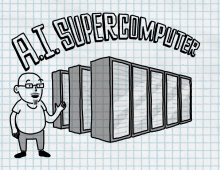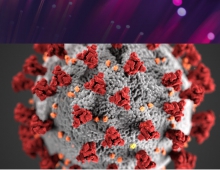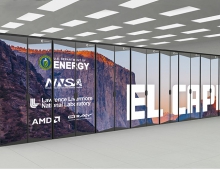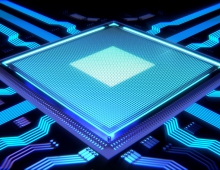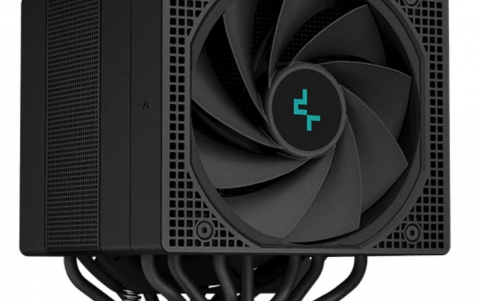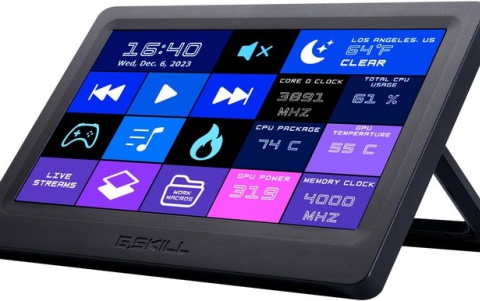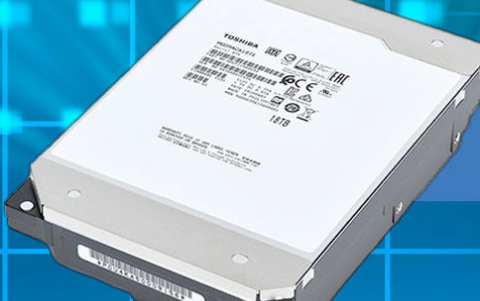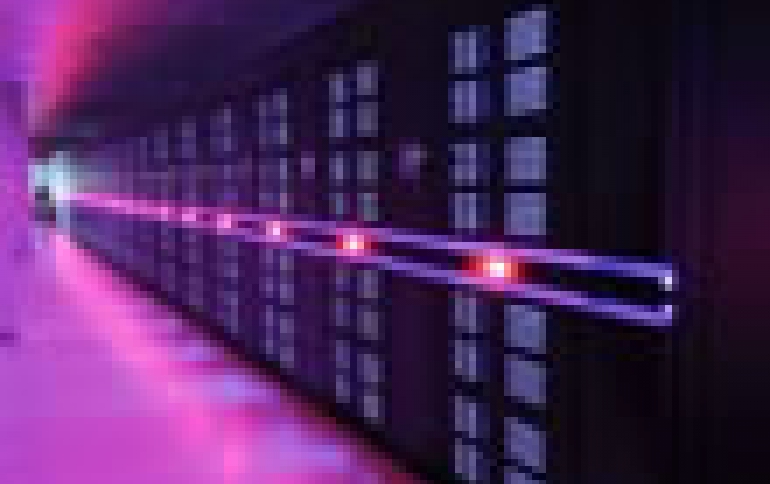
China's Tianhe-2 Supercomputer Takes No. 1 Ranking TOP500 List
Tianhe-2, a supercomputer developed by China's National University of Defense Technology, is the world?s new No. 1 system with a performance of 33.86 petaflop/s on the Linpack benchmark, according to the 41st edition of the twice-yearly TOP500 list of the world?s most powerful supercomputers.
Tianhe-2, or Milky Way-2, will be deployed at the National Supercomputer Center in Guangzho, China, by the end of the year. The surprise appearance of Tianhe-2, two years ahead of the expected deployment, marks China?s first return to the No. 1 position since November 2010, when Tianhe-1A was the top system. Tianhe-2 has 16,000 nodes, each with two Intel Xeon IvyBridge processors and three Xeon Phi processors for a combined total of 3,120,000 computing cores.
Titan, a Cray XK7 system installed at the U.S. Department of Energy's (DOE) Oak Ridge National Laboratory and previously the No. 1 system, is now ranked No. 2. Titan achieved 17.59 petaflop/s on the Linpack benchmark using 261,632 of its NVIDIA K20x accelerator cores. Titan is one of the most energy efficient systems on the list, consuming a total of 8.21 MW and delivering 2,143 Mflops/W.
Sequoia, an IBM BlueGene/Q system installed at DOE?s Lawrence Livermore National Laboratory, also dropped one position and is now the No. 3 system. Sequoia was first delivered in 2011 and has achieved 17.17 petaflop/s on the Linpack benchmark using 1,572,864 cores. Sequoia is also one of the most energy efficient systems on the list, consuming a total of 7.84 MW and delivering 2,031.6 Mflops/W.
Fujitsu's "K computer" installed at the RIKEN Advanced Institute for Computational Science (AICS) in Kobe, Japan, is now the No. 4 system with a performance of 10.51 Pflop/s on the Linpack benchmark using 705,024 SPARC64 processing cores
A second BlueGene/Q system, Mira, installed at Argonne National Laboratory is at No. 5 with 8.59 petaflop/s on the Linpack benchmark using 786,432 cores.
Rounding out the Top 10 are the upgraded Stampede at the Texas Advanced Computing Center of the University of Texas, Austin; JUQUEEN at the Forschungszentrum Juelich in Germany (and the most powerful system in Europe); an IBM BlueGene/Q system at Lawrence Livermore National Laboratory; SuperMUC, an IBM iDataplex system installed at Leibniz Rechenzentrum in Germany; and Tianhe-1A at the National Supercomputing Center in Tianjin, China.
According to TOP500 Editor Jack Dongarra, who toured the Tianhe-2 development facility in May, the system is noteworthy in a number of aspects. "Most of the features of the system were developed in China, and they are only using Intel for the main compute part. That is, the interconnect, operating system, front-end processors and software are mainly Chinese," Dongarra said.
Other highlights from the June 2013 TOP500 List include:
- There are 26 systems with performance greater than a petaflop/s, up from 23 six months ago.
- The new No. 1 system, Tianhe-2, and the No. 6 system, Stampede, are using Intel Xeon Phi processors to speed up their computational rate. The No. 2 system, Titan, and the No. 10 system, Tianhe-1A, are using NVIDIA GPUs to accelerate computation.
- A total of 54 systems on the list are using accelerator/co-processor technology, down from 62 in November 2012. Thirty-nine of these use NVIDIA chips, three use ATI Radeon, and eleven systems use Intel MIC technology (Xeon Phi).
- The number of systems installed in China has now stabilized at 66, with 72 and 68 on the last two lists. As a nation, China now holds the No. 2 position as a user of HPC, ahead of Japan, UK, France, and Germany. Due to Tianhe-2, China has also taken the No. 2 position in the performance share, ahead of Japan.
- Intel continues to provide the processors for the largest share (80.4 percent) of TOP500 systems.
- Eighty-eight percent of the systems use processors with six or more cores, and 67 percent with eight or more cores.
- IBM?s BlueGene/Q is still the most popular system in the TOP10 with four entries, including No. 3, 5, 7, and 8.
- The entry level on the list moved up to the 96.6 teraflop/s mark on the Linpack benchmark, compared to 76.5 Tflop/s six months ago.
- The last system on the newest list was listed at position 322 in the previous TOP500 just six months ago.
- Total combined performance of all 500 systems has grown to 223 Pflop/s, compared to 162 Pflop/s six months ago and 123 Pflop/s one year ago.
- The U.S. is clearly the leading consumer of HPC systems, with 252 of the 500 systems (250 last time). The European share (112 systems ? 105 last time) is still lower than the Asian share (119 systems ? 123 last time).
- Dominant countries in Asia are China with 66 systems (down from 72) and Japan with 30 systems (down from 32).
- In Europe, UK, France, and Germany, are almost equal with 29, 23, and 19 respectively.
Titan, a Cray XK7 system installed at the U.S. Department of Energy's (DOE) Oak Ridge National Laboratory and previously the No. 1 system, is now ranked No. 2. Titan achieved 17.59 petaflop/s on the Linpack benchmark using 261,632 of its NVIDIA K20x accelerator cores. Titan is one of the most energy efficient systems on the list, consuming a total of 8.21 MW and delivering 2,143 Mflops/W.
Sequoia, an IBM BlueGene/Q system installed at DOE?s Lawrence Livermore National Laboratory, also dropped one position and is now the No. 3 system. Sequoia was first delivered in 2011 and has achieved 17.17 petaflop/s on the Linpack benchmark using 1,572,864 cores. Sequoia is also one of the most energy efficient systems on the list, consuming a total of 7.84 MW and delivering 2,031.6 Mflops/W.
Fujitsu's "K computer" installed at the RIKEN Advanced Institute for Computational Science (AICS) in Kobe, Japan, is now the No. 4 system with a performance of 10.51 Pflop/s on the Linpack benchmark using 705,024 SPARC64 processing cores
A second BlueGene/Q system, Mira, installed at Argonne National Laboratory is at No. 5 with 8.59 petaflop/s on the Linpack benchmark using 786,432 cores.
Rounding out the Top 10 are the upgraded Stampede at the Texas Advanced Computing Center of the University of Texas, Austin; JUQUEEN at the Forschungszentrum Juelich in Germany (and the most powerful system in Europe); an IBM BlueGene/Q system at Lawrence Livermore National Laboratory; SuperMUC, an IBM iDataplex system installed at Leibniz Rechenzentrum in Germany; and Tianhe-1A at the National Supercomputing Center in Tianjin, China.
According to TOP500 Editor Jack Dongarra, who toured the Tianhe-2 development facility in May, the system is noteworthy in a number of aspects. "Most of the features of the system were developed in China, and they are only using Intel for the main compute part. That is, the interconnect, operating system, front-end processors and software are mainly Chinese," Dongarra said.
Other highlights from the June 2013 TOP500 List include:
- There are 26 systems with performance greater than a petaflop/s, up from 23 six months ago.
- The new No. 1 system, Tianhe-2, and the No. 6 system, Stampede, are using Intel Xeon Phi processors to speed up their computational rate. The No. 2 system, Titan, and the No. 10 system, Tianhe-1A, are using NVIDIA GPUs to accelerate computation.
- A total of 54 systems on the list are using accelerator/co-processor technology, down from 62 in November 2012. Thirty-nine of these use NVIDIA chips, three use ATI Radeon, and eleven systems use Intel MIC technology (Xeon Phi).
- The number of systems installed in China has now stabilized at 66, with 72 and 68 on the last two lists. As a nation, China now holds the No. 2 position as a user of HPC, ahead of Japan, UK, France, and Germany. Due to Tianhe-2, China has also taken the No. 2 position in the performance share, ahead of Japan.
- Intel continues to provide the processors for the largest share (80.4 percent) of TOP500 systems.
- Eighty-eight percent of the systems use processors with six or more cores, and 67 percent with eight or more cores.
- IBM?s BlueGene/Q is still the most popular system in the TOP10 with four entries, including No. 3, 5, 7, and 8.
- The entry level on the list moved up to the 96.6 teraflop/s mark on the Linpack benchmark, compared to 76.5 Tflop/s six months ago.
- The last system on the newest list was listed at position 322 in the previous TOP500 just six months ago.
- Total combined performance of all 500 systems has grown to 223 Pflop/s, compared to 162 Pflop/s six months ago and 123 Pflop/s one year ago.
- The U.S. is clearly the leading consumer of HPC systems, with 252 of the 500 systems (250 last time). The European share (112 systems ? 105 last time) is still lower than the Asian share (119 systems ? 123 last time).
- Dominant countries in Asia are China with 66 systems (down from 72) and Japan with 30 systems (down from 32).
- In Europe, UK, France, and Germany, are almost equal with 29, 23, and 19 respectively.

